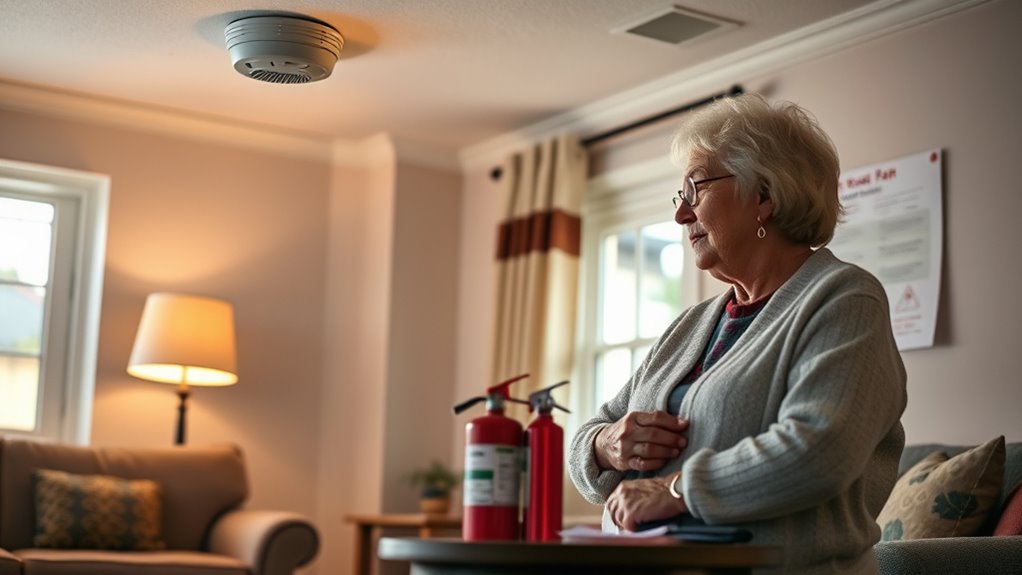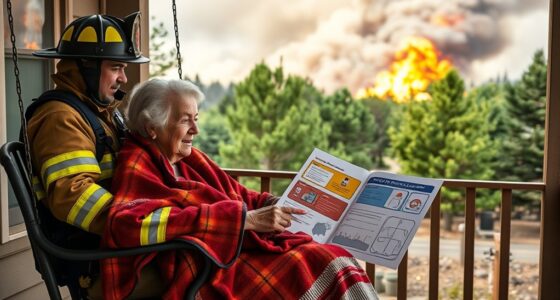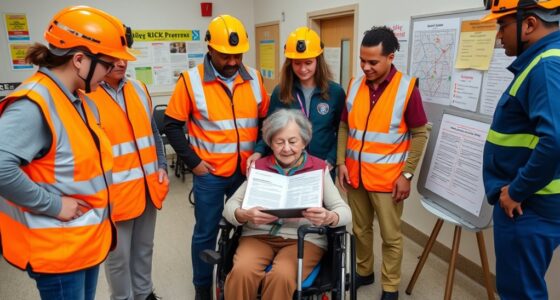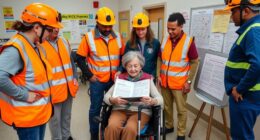To guarantee fire safety for seniors, create clear evacuation plans with two routes from each room and practice them regularly. Install interconnected smoke alarms that sound throughout the house and check them monthly, replacing batteries twice a year and detectors every ten years. Keep pathways clear and well-lit, and consider adding a flashlight nearby. Staying proactive with maintenance and planning can greatly reduce risks—continue exploring ways to keep your home safer and more prepared.
Key Takeaways
- Develop a clear evacuation plan with two accessible escape routes from each room.
- Regularly practice fire drills to ensure quick, confident responses during emergencies.
- Maintain smoke detectors monthly, replace batteries twice annually, and install interconnected alarms for full coverage.
- Keep exit pathways well-lit, unobstructed, and equipped with a flashlight for emergencies.
- Update safety plans regularly and inform neighbors or caregivers to assist in fire situations.
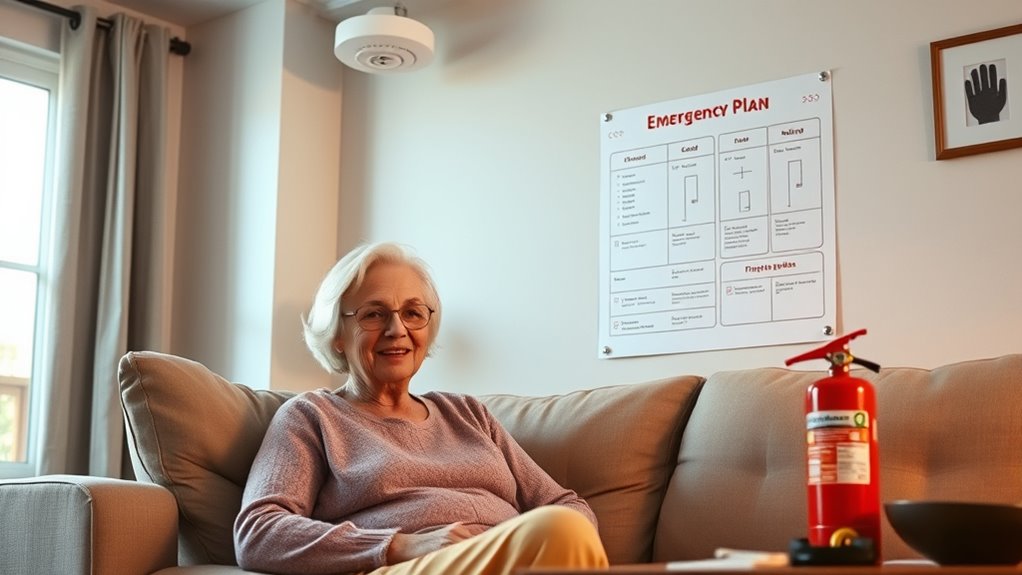
Fire safety is especially important for seniors, as age-related changes can increase the risk of fire injuries and make quick escapes more difficult. To protect yourself, you need a clear plan that includes well-practiced evacuation procedures. Knowing exactly how to get out safely can make all the difference in an emergency. Start by identifying two escape routes from each room, ensuring they’re free of clutter and easy to access. Practice these routes regularly so you can move quickly if a fire occurs. It’s also wise to establish a safe meeting spot outside your home where everyone can gather and be accounted for after escaping. Having a plan and practicing it regularly helps you stay calm and confident during an actual fire.
Another critical aspect of fire safety is maintaining your smoke detectors. Smoke detectors are your first alert in a fire, and their proper functioning can give you crucial extra seconds to escape. Check your smoke detectors at least once a month by pressing the test button to ensure they’re working correctly. Replace the batteries twice a year or immediately if they start to chirp, indicating low power. It’s also a good idea to replace the entire smoke detector every ten years, as sensors can become less reliable over time. Keep your detectors clean by gently vacuuming around them to remove dust and cobwebs that could interfere with their operation. Proper maintenance of smoke detectors ensures their optimal performance and early warning capability. Regular testing and battery replacement are essential for reliable operation. Additionally, incorporating wireless interconnected alarms can improve overall safety by alerting all areas of your home simultaneously. Remember, a well-maintained smoke detector is essential for early warning and safety. Additionally, understanding the importance of power sources for alarms can help you choose the best options for continuous protection.
In addition to maintaining your smoke detectors and establishing evacuation procedures, consider installing interconnected alarms throughout your home. When one smoke detector goes off, all alarms should sound, alerting everyone in the house, even if they’re in different rooms. This interconnected system ensures that no one misses the warning, especially when quick action is needed. Keep a flashlight nearby in case of power outages, and ensure pathways to exits are well-lit and unobstructed. It’s also smart to inform your family members or neighbors about your fire safety plan so they can assist if necessary.
Frequently Asked Questions
How Often Should Fire Drills Be Conducted at Home?
You should conduct fire drills at home at least twice a year to guarantee preparedness. Regular fire drill frequency helps reinforce senior safety protocols and keeps everyone familiar with escape routes. As a senior or caregiver, you need to practice these drills, especially if there are mobility challenges. This consistency ensures that, in an emergency, everyone reacts quickly and confidently, reducing risks and promoting safety for all household members.
What Specific Fire Alarm Features Are Best for Seniors?
Imagine your home has a vigilant guardian watching over you. The best fire alarms for seniors feature smart sensors that detect smoke early, triggering swift alerts. Voice alerts act like a caring voice guiding you to safety, reducing confusion during emergencies. These features guarantee you’re informed promptly and clearly, helping you respond quickly. Opt for alarms with these capabilities to create a safer environment, like a trusted guardian always watching out for you.
Are There Government Programs Offering Free Fire Safety Devices for Seniors?
You might wonder if government programs offer free safety devices for seniors. Many local and federal initiatives provide access to free safety devices like smoke alarms and carbon monoxide detectors to help protect you. These programs aim to improve your safety at home. To find out if you qualify, contact your local fire department or senior services. Taking advantage of these resources can give you added peace of mind and guarantee your safety.
How Can Caregivers Assist Seniors With Fire Safety Plans?
You can help seniors by creating clear evacuation procedures they can easily follow. Make sure they know how to safely exit their home and practice these steps regularly. Additionally, assist them in compiling a list of emergency contacts, including local fire services and family members. Reinforce the importance of having alarms working properly and guarantee they understand how to respond quickly in case of a fire emergency.
What Are Common Fire Hazards Unique to Seniors’ Homes?
You should be aware that common fire hazards in seniors’ homes include overloaded outlets, unmaintained heating devices, and clutter blocking escape routes. These hazards threaten home safety by increasing fire risk and limiting escape options. Regularly checking electrical cords, keeping fireplaces and space heaters well-maintained, and decluttering guarantee better home safety. Addressing these hazards proactively helps protect seniors and reduces the chance of fire-related injuries.
Conclusion
Think of your fire safety plan as a sturdy lighthouse guiding you through stormy nights. By installing alarms, practicing drills, and having a clear escape plan, you’re illuminating the path to safety. Stay proactive and prepared; your home can be a fortress against fire hazards. Remember, safety isn’t just a plan — it’s the lighthouse that keeps you grounded and protected, guiding you safely back to the shore no matter how dark the night.
